 Leading Blog | Posts by Month |
 Leading Blog | Posts by Month |
10.31.11

LeadershipNow 140: October 2011 Compilation
Posted by Michael McKinney at 05:46 PM
10.28.11

No Fear of Failure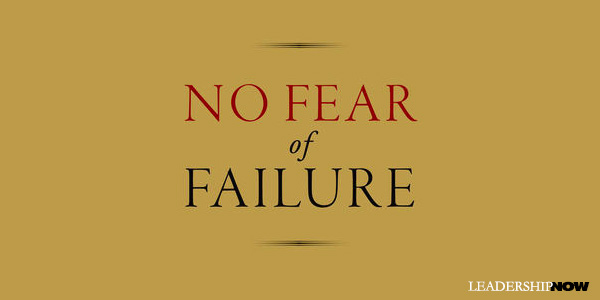
GARY BURNISON, CEO of Korn/Ferry International, shares one-on-one conversations with a dozen successful leaders in No Fear of Failure. He found a common theme in these conversations: they each “exhibited tremendous courage around the possibility, and even the inevitability at times, of failure. In the face of uncertainty, they draw on an inner strength that allows them to strive for what is possible rather than become paralyzed by the risk of failure.” Indra Nooyi, chairman, and CEO of PepsiCo, on Learning: “The one thing I have learned as a CEO is that leadership at various levels is vastly different….As you move up the organization, the requirements for leading that organization doesn’t grow vertically; they grow exponentially….If you want to improve the organization, you have to improve yourself and the organization gets pulled up with you….Just because you are a CEO, don’t think you have landed. You must continually increase your learning, the way you think, and the way you approach the organization.” Vicente Fox, former president of Mexico, on Humility: “The higher leaders rise, the further they move from where they began. The danger is that success will undermine their humility, leaving them out of touch and disconnected….There are so many temptations that would undermine your humility. You have to develop that part, work on it all your life. It’s easy to fall on the other side, especially when you are in power and have a position.” Daniel Vasella, MD, chairman of Novartis AG on Stewardship: A vineyard owner pointed to a stone wall and explained how his grandfather had started building it and then his father added to it as did he. Vasella “found this to be a fascinating analogy. It’s like no great cathedral was build in one generation. There are several implications. First, you’re not here to take advantage but rather to add. Second, you will not finish. Third, it is very important that the overall vision of what is being built be shared by several people over time.” Coach John McKissick, the “winningest” coach in football on Coaching: “I don’t coach football, I coach kids.” His code is “to live clean, think clean, and stop doing all the things that will destroy them physically, mentally, and morally, and to start doing things that will make them cleaner, finer, and more competent. That’s not a sacrifice. I tell them that all the time. ‘I’m helping you be a better person and a better player.’” One of the most important leadership lessons Burnison learned in his career was that “leadership is all about the other person. No matter the topic—whether someone is being fired or has just told you about a serious health issue—that person should leave your office feeling better than when he or she entered.… For the CEO there is no off-the-cuff remark. Leadership demands introspection and an understanding of the clout that one’s words and actions carry.” The conversations Burnison shares will influence your leadership in profound ways. As leaders, we need to keep learning. It’s key to our success. It’s sad how many leaders do not actively pursue their own leadership development. This book will help. 
Posted by Michael McKinney at 09:49 AM
10.26.11

It’s Not About You It’s Not About You (Reissued as The Go-Giver Leader) by Bob Burg and John David Mann, is the story of a leader’s journey. A journey any good leader has to take.
It’s Not About You (Reissued as The Go-Giver Leader) by Bob Burg and John David Mann, is the story of a leader’s journey. A journey any good leader has to take.
Ben begins with an agenda. His job is to convince or if necessary, to steamroll a manufacturer of high-quality chairs to accepting a merger. Ben’s company believes it to be a good thing, but the target company is not so sure. Ben’s mindset as he starts out is: “how do I get them to do what I want them to do.” Somewhere between getting people to understand him and slowing-down long enough to understand them, he found his answer. Through a series of encounters with a mentor—Aunt Elle—and a lot of reflection Ben comes to understand that it is not about him. His journey causes him to reflect on five lessons: Lesson #1: Hold the Vision. The hard part isn’t coming up with the vision, it’s holding on to the vision. “As a leader, your job is to hold fast to the big picture, to keep seeing it in your mind’s eye, with crystal clarity, where it is you are going—that place that right at this moment exists only in your mind's eye. And to keep seeing that, even when nobody else does.” Lesson #2: Build Your People. “People have all sorts of amazing qualities and natural abilities trapped inside them. With the wood, it’s knowing how to apply the heat. With people, it’s applying your belief.” If you give people something great to live up to, they usually will. “How influential you are, comes down to your intention. What are you focused on? Your benefit, or theirs?” The more you yield, the more power you have. Lesson #3: Do the Work. Be humble and stay grounded. Aunt Elle said, “People who achieve great things that the world will never forget, start out by accomplishing small things the world will never see.” Lesson #4: Stand for Something. Lead from who you are. People will figure it out anyway. People need to trust your competence, but they need to trust your character more. “Competence is simply the baseline, the thing that puts you in the game. It matters, but honestly, it’s a dime a dozen.” The authors remind us that you can only lead as far as you grow. Aunt Elle says, “What you have to give, you offer least of all through what you say; in greater part through what you do; but in greatest part through who you are.” Lesson #5: Share the Mantle. It’s not about you. “You are not their dreams, you are only the steward of those dreams. And leaders often get it backwards and start thinking they not only hold the best of others but they are the best….The moment you start thinking it’s all about you, that you’re the deal, is the moment you begin losing your capacity to positively influence others’ lives.” Whatever great parenting looks like, it is not about the parent. The Go-Giver Leader is a great presentation of solid life lessons. A book to be read and passed around. Unfortunately, “it’s not about you,” is not the kind of lesson that once learned, is always remembered. If it was, fewer great leaders would finish poorly after so many years of outstanding service. This is an issue that we face over and over again, but hopefully in ever diminishing frequency and intensity as our leadership matures. This book is a great reminder of the power of the right kind of leadership; leadership that comes from an inner strength of understanding, service and outgoing concern for others.

Posted by Michael McKinney at 09:29 PM
10.24.11

Great by Choice
IT IS A defeatist attitude to think that luck or circumstances primarily make you what you are. Luck, both good and bad happen to us all. We cannot control much of what happens around us, but the choices we make, as Jim Collins and Morten Hansen’s research confirms, determine our success. In Great by Choice, the authors rightfully assert that we have entered an extended period of uncertainty and turbulent disruption that might well characterize the rest of our lives. The question then is, what is required to perform exceptionally well in such a world?. For their study, the authors chose a set of major companies that achieved spectacular results over 15 or more years while operating in unstable environments. They call these companies "10Xers" for providing shareholder returns at least 10 times greater than their industry. Then the authors compared those companies—Amgen, Biomet, Intel, Microsoft, Progressive Insurance, Southwest Airlines, Stryker—to similar, but less successful, "control" companies: Genentech, Kirschner, AMD, Apple, Safeco, PSA and United States Surgical.
Fanatic Discipline: Extreme consistency of action. Don’t overreact to events.
10X Leadership Behaviors 20-Mile March: This is the discipline to stay the course in both good times and bad. This means maintaining a lower bound and an upper bound, a hurdle that you jump over and a ceiling that you will not rise above, the ambition to achieve and the self-control to hold back. A 20-Mile March provides a tangible point of focus that keeps you moving forward. Fire Bullets, then Cannonballs: 10Xers increase their luck by firing lots of bullets instead of a big un-calibrated cannonball. The underlying principle is, be creative, but validate your creative ideas with empirical experience. Leading above the Death Line: 10Xers build in buffers because the only mistakes you can learn from are the ones you survive. They zoom-in and zoom out to manage risk and recognize luck. SMaC: Specific, Methodical and Consistent. Tactics change from situation to situation, whereas SMaC practices can last for decades and apply across a wide range of circumstances. “Steve Jobs didn’t so much revolutionize the company as he returned it to the principles he’d used to launch the company from garage to greatness two decades earlier.” There is always the struggle to find the balance between continuity and change. I find too many are wedded to one ditch or the other. Certainly luck plays a part. The authors found that the difference between the 10X companies and the comparison companies wasn’t the good or bad luck they got, but what they did with it. Key comment regarding luck: “If the ratio of head to tails tends to even out over time, we need to be skilled, strong, prepared, and resilient to endure the bad luck long enough to eventually get good luck.” Mountain climber “Malcom Daly had to be lucky enough to survive the fall, but he also had to be strong, skilled, and resilient before the 44 hours of peril after his two-hundred-foot fall.” The organizations they studied were paranoid about chance events and complex forces out of their control, but they focused on what they could do, seeing themselves as ultimately responsible for their choices and accountable for their performance—no matter what the sequence of coin flips. A thought provoking book that, like Collin’s other work, takes us back to basics. In conclusion they ask: When the moment comes—when we’re afraid, exhausted, or tempted—what choice do we make? Do we abandon our values? Do we give in? Do we accept average performance because that’s what most everyone else accepts? Do we capitulate to the pressure of the moment? Do we give up on our dreams when we’ve been slammed by brutal facts?

Posted by Michael McKinney at 10:57 AM
10.21.11

Practical Genius is a ChoiceEveryone is born a genius, but the process of living de-geniuses you.Gina Rudan’s Practical Genius is designed to re-genius you. Gina says we all have the capacity for what she terms, practical genius. It is the “kind of practical, street-level, everyday genius that can change the game for you, your business, and every aspect of your life.” Practical genius is a choice. So many of us are unconsciously compromising some of our greatest natural assets because of external factors, past hurts, or current fears. Or, even worse, we have sacrificed our skills, strengths, and passion to the expectations and influence of others. Or we’re consciously hitting the snooze button, rolling over and going back to slept every time we’re reminded how far from feeling happy and fulfilled we are in our work and personal lives.In order to identify and leverage both the hard and soft unique personal assets we all possess, Gina has created a 5-step plan: Step 1: Identify Your Genius. Through a series of reflective exercises you identify your hard assets—skills, strengths and expertise—and your soft assets—passions, creative abilities and values. Where these strengths intersect is your own unique practical genius lies. “Reach to the farthest edges, the fringes of your curiosities, and spend some serious time there.” Step 2: Express Your Genius. You must actively and purposefully tell your story. Without visibility, you’re compromising your impact. “A person without a story is invisible.” Step 3: Surround Yourself with Genius. You are who you walk with. Relationships are choices not accidents. Identify others of your “tribe” that can help you amplify your genius. To build a tribe that feeds, supports, and roots for you, you have to feed, support, and root for them. Step 4: Sustain Your Genius. Find what fuels you. Consider your routines and practice those that keep you healthy, productive, and prosperous. In addition to food, exercise and sleep, “do one thing every day that represents a conscious effort to expose yourself to the extraordinary instead of the ordinary, the profound instead of the pedestrian, the breathtaking instead of the mind-numbing.” Step 5: Market Your Genius. Live and work at the intersection of all your assets. Project your paradox. “Market the scholar alongside the fool. The entrepreneur alongside the philosopher. The conservationist alongside the game designer.” Know your audience and build relationships with them.

Posted by Michael McKinney at 05:48 PM
10.14.11

5 Leadership Lessons: EntreLeadership Dave Ramsey defines EntreLeadership as “the process of leading to cause a venture to grow and prosper.” Entreleaders know how to blend their entrepreneurial passion with servant-like leadership that motivates employees through persuasion instead of intimidation. EntreLeadership is a book about how business works from a practitioner. His advice, on nearly every facet of running a business, is based on solid principles. Here are just a few of his thoughts on leadership: 
Posted by Michael McKinney at 05:25 PM
10.10.11

Maxwell's 5 Levels of Leadership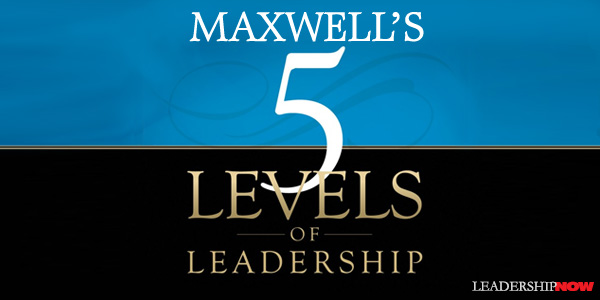
OVER 30 years ago, John Maxwell began developing the 5 Levels of Leadership. It has been presented before but never to this depth and completeness. The 5 Levels express a way to understand and organize your leadership growth. Each of the levels builds on the previous one and you can only progress to the next level once you have mastered the previous level. As you go higher it is easier to lead because your influence grows as well, as your leadership becomes more service-oriented. Maxwell says it takes longer than you think to get to the top level—and many never do. At the same time, you can go down very quickly. But if you have developed the right kinds of relationships with others, they will support you through your missteps and fumbles. As shown below, the first level is POSITION. At this level, people follow you because they have to. Your influence comes from your position. While that’s not bad—you probably got the position because of your leadership potential—you don’t want to stay here. Leadership is about relationships and leaders will make it their business to develop them. The second level is PERMISSION. People follow you because they want to. Permission is about building relationships. It focuses on the value of each person and opens up communication. Connecting with others begins with connecting with and growing yourself. Understanding that the first person I must get along with is me, the first person to cause me problems is me, the first person that must change is me, and the first person that can make a difference is me. Level three – PRODUCTION – recognizes that relationships alone are not enough. A leader is tasked with getting things done. Production level leaders are followed because of what they have done for the organization. They get things done. Their credibility is based on their example. The ability to get results alone doesn’t make you a leader. Leaders are measured by what the entire group accomplishes and not by the individual efforts of the person in charge. Leaders develop their people into a team to get results. To get to the next level you must develop your people. The fourth level is PEOPLE DEVELOPMENT. Leaders become great because they empower others. They develop more leaders. “Production may win games, but People Development wins championships.” People development assures that growth can be sustained. Self-centered, insecure leaders neglect this stage in their development. Maxwell estimates that less than 1 percent of all leaders ever reach Level 5 – THE PINNACLE. Leaders at this level understand that the highest goal of leadership is to develop more leaders, not to gain followers or do work. Level 5 leaders develop Level 4 leaders. Developing leaders that can, in turn, develop leaders is hard work and takes a great deal of skill, focus, and a lifetime commitment. But those leaders that do create Level 5 organizations. They create opportunities that other leaders don’t. Level 5 leaders leverage their own leadership through others. People follow these leaders because of what they are and what they represent. “When you lead an organization, you can’t be focused on just fulfilling the vision or getting work done.” 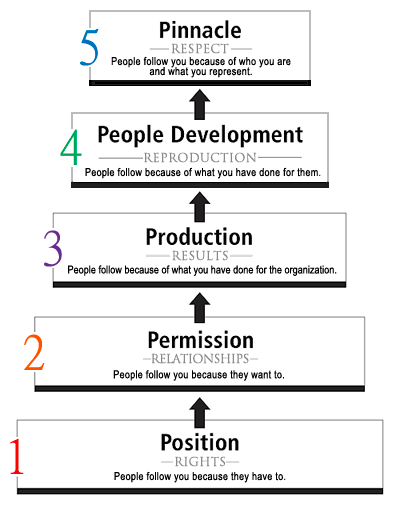 In addition to describing each of the Levels in detail, Maxwell shares upside and downside of each Level, how the 21 Irrefutable Laws of Leadership relate to each Level, an assessment to gauge your current level of leadership, and most practical, a growth guide to help you understand the mindset needed to move from one level to the next.

Posted by Michael McKinney at 07:26 AM
10.07.11

Work-Life Balance?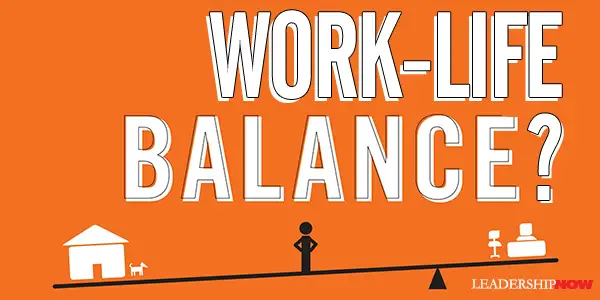
THE TERM work-life balance is fatally flawed says Matthew Kelly in Off Balance. Meant to deal with the pressures surrounding both personal and professional life, the term has unwittingly created a false dichotomy. You can’t separate the two. In fact, says Kelly, “the term itself diminishes our ability to make the case that work can be a richly rewarding part of a person’s life and should in many ways be personal.” What people really want (and need) is not work-life balance, but to “live deeply satisfying lives both personally and professionally.” The trick is to get in touch with your dissatisfaction and then strategically create the life you want. But it will take some work. It’s not going to happen accidentally. Kelly writes, “The life you desire is there for the taking, but it comes at a cost. Life, like business, hinges on the successful allocation of scarce resources.”
We seem more interested in how we want to live than we are in discovering the best way to live. Likewise, we are much more interested in developing self-expression than we are in developing selves that are worth expressing. Personal preference has triumphed over the pursuit of excellence. We want what we want, and we feel entitled to get what we want. So we need to begin with self-knowledge. “Satisfaction does not arise from simply having experiences and things, but rather from having the experiences and things that you deem important.” Kelly has developed a system to increase the level of personal and professional satisfaction in your life that involves five steps, beginning of course with assessment: Assessment. What brings you satisfaction? (There is an Off-Balance Assessment in the book and online at FloydConsulting.com) This process says Kelly, allows us to pinpoint an element of our dissatisfaction and create a prescription to overcome it. Priorities. What matters most to you? While these may change over time, it is essential that we clearly define them or we become victims of the tyranny of the urgent. Core Habits. What are the daily habits that keep you healthy, focused, and energized? For example, workout, meditation, proper diet, maintaining relationships. “What one thing, if done every day, would change your life markedly?” Weekly Strategy Session. What is the key project that should have your attention and be your starting point for each day of the week? Our lives are destined for underachievement and dissatisfaction if we don’t learn to plan and strategize personally. Quarterly Review. Every three months review what is working well in your life, review what you said you would do in the last ninety days; outline the key objectives in your life at this time; share your plan to accomplish these objectives. Kelly says that knowing how to balance various activities in our life to produce the maximum flow of energy is perhaps the most important skill any of us can learn and develop. “Each day has a focus, and holding to this focus plays a significant role in creating and sustaining high levels of satisfaction.” He concludes, “To lay your head on your pillow at night, knowing that who you are and what you do makes sense … now, that is satisfaction.”

Posted by Michael McKinney at 03:00 PM
10.06.11

Stimulus Package 4 - Free Book: Up, Down, or Sideways Here’s a stimulus package to get you thinking. It’s a package designed to serve as a catalyst to help you to find ways to make things work and get things done. While you might think of it as a piece of good fortune, don’t think of it as a bailout. You’ve still got to do the inside work. Here’s a stimulus package to get you thinking. It’s a package designed to serve as a catalyst to help you to find ways to make things work and get things done. While you might think of it as a piece of good fortune, don’t think of it as a bailout. You’ve still got to do the inside work.
In partnership with Mark Sanborn, we are giving away three autographed copies of Up, Down, or Sideways: How to Succeed When Times are Good, Bad, or In Between. Up, Down, or Sideways answers the question: What should we consistently do to ensure present and future success? For a chance to receive a free copy, you must do two things. First, leave a comment by midnight, Monday, October 10th, on this post about what methods and mindsets you have practiced when times were Up or Sideways that are paying dividends now that times are Down or what interests you about this book. Secondly, Tweet a link to this post or if you don’t have a Twitter account, you can use Facebook. On Tuesday, October 11, 2011 we will randomly select three recipients to receive a free copy. We will contact you by e-mail for your address. Related Interest:
Posted by Michael McKinney at 08:27 AM
10.05.11

Steve Jobs 1955-2011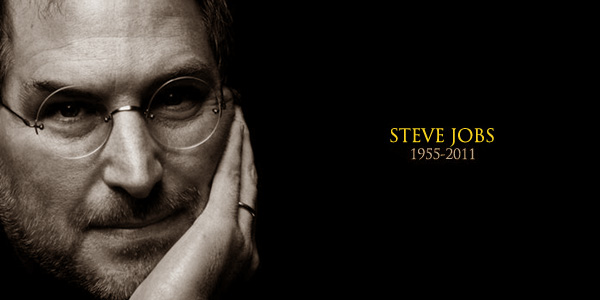
ONE of the most remarkable innovators of our time, Steve Jobs has been called a Henry Ford, a Walt Disney, a Thomas Edison. "We are deeply saddened to announce that Steve Jobs passed away today," Apple said. "Steve's brilliance, passion, and energy were the source of countless innovations that enrich and improve all of our lives. The world is immeasurably better because of Steve." Here are a selection of his thoughts on life: We don’t get a chance to do that many things, and every one should be really excellent.
I want to put a ding in the universe. You can’t connect the dots looking forward; you can only connect them looking backwards. So you have to trust that the dots will somehow connect in your future. You have to trust in something—your gut, destiny, life, karma, whatever. This approach has never let me down, and it has made all the difference in my life. Remembering that I'll be dead soon is the most important tool I've ever encountered to help me make the big choices in life. Because almost everything — all external expectations, all pride, all fear of embarrassment or failure - these things just fall away in the face of death, leaving only what is truly important. Remembering that you are going to die is the best way I know to avoid the trap of thinking you have something to lose. You are already naked. There is no reason not to follow your heart. No one wants to die. Even people who want to go to heaven don't want to die to get there. And yet death is the destination we all share. No one has ever escaped it. And that is as it should be, because Death is very likely the single best invention of Life. It is Life's change agent. It clears out the old to make way for the new. Right now the new is you, but someday not too long from now, you will gradually become the old and be cleared away. Sorry to be so dramatic, but it is quite true. Your time is limited, so don't waste it living someone else's life. Don't be trapped by dogma — which is living with the results of other people's thinking. Don't let the noise of others' opinions drown out your own inner voice. And most important, have the courage to follow your heart and intuition. They somehow already know what you truly want to become. Everything else is secondary. Jobs told the Wall Street Journal, “Being the richest man in the cemetery doesn’t matter to me … Going to bed at night saying we’ve done something wonderful… that’s what matters to me.” And he did.
Posted by Michael McKinney at 05:47 PM

Are You Up, Down, or Sideways?
THERE are no guarantees in life. We can be proactive, but there are some things that are completely outside of our control. So if we can’t be proactive on everything, we can, Mark Sanborn suggests, be interactive. We must learn how to interact with the forces in our life that are bigger than we are to create the outcomes we desire. No matter where we are—up, down, or sideways—there are things we can do to mitigate the downs, take advantage of the ups and maximize the sideways times in our life. Up, Down, or Sideways by Mark Sanborn is a thoughtful book born of experience and based on sound principles. It would be a mistake to think of this as another business book. It is, in fact, a life book that will deeply impact your business.To be interactive, you first need to define your scorecard for success. Most people don’t live the life they imagined because “they are stuck using a scoring system that doesn’t fit the game they want to play.” Sanborn guides you in developing a scoring system that is meaningful, long-term, and personal. Besides a clear scoring system, your success also depends on your attitude. You must develop an optimistic attitude. “The way you look at yourself and the world around you affects your success regardless of the circumstances.” We can choose what we focus on. Another important mindset is that of the lifelong learner. “The more you learn, the more prepared you are for whatever comes your way. And the more you learn, the more you develop behavioral flexibility that provides a distinct advantage over your competition.” Sanborn offer six methods to succeed when times are Up, Down, or Sideways.
Sanborn gives some final reminders: When you’re Up, you need humility and perspective. So surround yourself with people who keep you grounded. When you’re Sideways, you need a boost. So surround yourself with people who challenge you to keep moving in the right direction. And finally, when you’re Down, you need hope. So surround yourself with people who lift your spirits. Certainly this is an important book for these times, but this book is meant to help your thrive no matter what life throws your way. You need this book—young people need this book—to prepare for the rest of your life, whether you are Up, Down, or Sideways. Read, reread, and refer.

Posted by Michael McKinney at 07:08 AM
10.03.11

Innovation Creates Uncertainty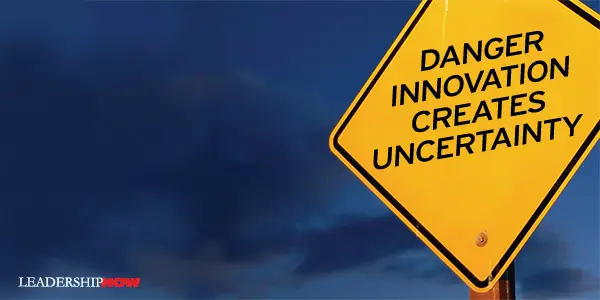
WE don’t like uncertainty. It’s not comfortable. We want innovation. We like creativity. It’s engaging. But innovation creates uncertainty. So while we say we want creativity and innovation we often reject it because it is new, different and risky. It takes us to places that we are not familiar with and places where we don’t have all the answers. The irony is that while we say we like innovation we develop a deep bias against it. Interestingly, a recent study from Cornell University states that “Anti-creativity bias is so subtle that people are unaware of it, which can interfere with their ability to recognize a creative idea.” In other words, our aversion to uncertainty means we find it difficult to even recognize a creative idea when we see it, focused as we are on removing the risky, uncomfortable strain on the status quo. Consequently, new ideas are often rejected out-of-hand in favor of the tried and trusted at times when we need new ideas the most. This resistance is so strong at times that even supporting objective evidence may not help break down barriers. The study concludes, “Our results show that regardless of how open minded people are, when they feel motivated to reduce uncertainty either because they have an immediate goal of reducing uncertainty, or feel uncertain generally, this may bring negative associations with creativity to mind which result in lower evaluations of a creative idea.” If you want to change the world, get comfortable with the uncomfortable.
Posted by Michael McKinney at 07:58 AM
10.02.11

First Look: Leadership Books for October 2011Here's a look at some of the best leadership books to be released in October.




For bulk orders call 1-800-423-8273  Build your leadership library with these specials on over 120 titles. All titles are at least 40% off the list price and are available only in limited quantities.
Posted by Michael McKinney at 09:05 AM
|
BUILD YOUR KNOWLEDGE


How to Do Your Start-Up Right STRAIGHT TALK FOR START-UPS 
Grow Your Leadership Skills NEW AND UPCOMING LEADERSHIP BOOKS 
Leadership Minute BITE-SIZE CONCEPTS YOU CAN CHEW ON 
Classic Leadership Books BOOKS TO READ BEFORE YOU LEAD |
|